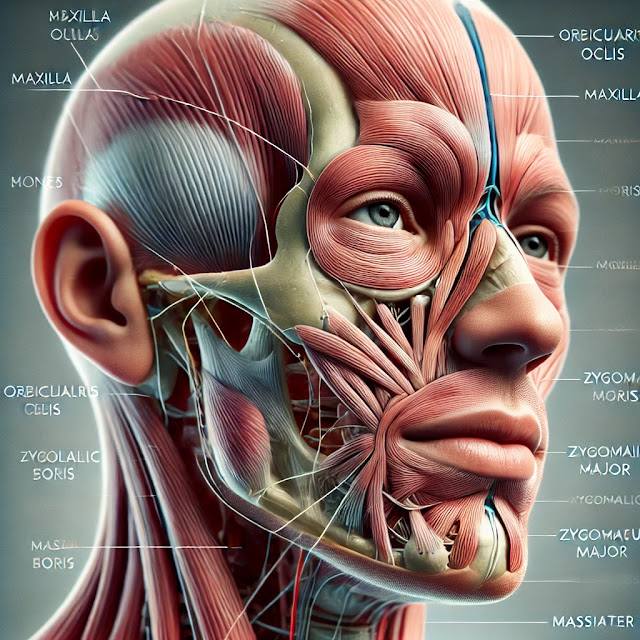The Ultimate Guide to Facial Structure & Anatomy: Understanding the Human Face
The human face is an intricate structure composed of bones, muscles, and soft tissues that define its unique appearance and functionality. From the rigid framework of facial bones to the delicate network of muscles controlling expressions, understanding facial anatomy is crucial in medical science, aesthetic studies, and even psychology. This comprehensive guide explores everything you need to know about the face, including the names of facial bones, the number of muscles in the face, and the causes of facial asymmetry.
The Anatomy of the Face: A Detailed Breakdown
The face is responsible for communication, sensory perception, and expression. It consists of various anatomical components, each serving a crucial function.
1. Names of Facial Bones: The Skeletal Foundation of the Face
The human skull consists of 22 bones, with 14 forming the facial skeleton. These bones provide structure, support vital organs, and serve as attachment points for facial muscles.
The 14 Facial Bones Include:
Maxilla (2): Forms the upper jaw and part of the eye socket.
Mandible (1): The strongest and only movable bone of the face, forming the lower jaw.
Zygomatic Bones (2): Commonly known as the cheekbones, they shape the mid-face structure.
Nasal Bones (2): Small paired bones that form the bridge of the nose.
Lacrimal Bones (2): Located in the inner eye socket, supporting tear ducts.
Palatine Bones (2): Form the posterior part of the hard palate and contribute to the nasal cavity structure.
Inferior Nasal Conchae (2): Thin bones in the nasal cavity that aid airflow and filtration.
Vomer (1): A single bone that forms part of the nasal septum.
2. Muscles of the Face: The Engine of Expression
The face contains approximately 42 individual muscles, allowing a wide range of expressions, from smiling to frowning. These muscles can be classified into two primary groups:
Muscles of Facial Expression
These muscles are unique as they insert into the skin rather than bones, allowing dynamic facial movements. Some of the key muscles include:
Orbicularis Oculi: Controls eyelid movements, enabling blinking and winking.
Orbicularis Oris: Responsible for lip movement, playing a crucial role in speech and expressions.
Zygomaticus Major & Minor: Essential for smiling by elevating the corners of the mouth.
Frontalis: Elevates the eyebrows, contributing to expressions of surprise.
Muscles of Mastication (Chewing)
These deeper muscles control jaw movement, assisting in chewing and speaking. They include:
Masseter: One of the strongest muscles, responsible for jaw closure.
Temporalis: Aids in jaw elevation and retraction.
Pterygoid Muscles: Assist in side-to-side jaw motion and grinding movements.
3. Why Do Some People Have Asymmetrical Faces?
Facial asymmetry is a natural characteristic, and no human face is perfectly symmetrical. Several factors contribute to differences in facial structure:
Genetic and Developmental Factors
Inherited traits play a significant role in facial structure.
Bone growth, muscle development, and external influences in childhood affect facial symmetry.
Environmental and Lifestyle Factors
Sleeping Habits: Consistently sleeping on one side may cause subtle asymmetry over time.
Injury or Trauma: Fractures or damage to facial bones can lead to long-term asymmetry.
Aging Process: Loss of skin elasticity and muscle tone contributes to changes in facial balance.
Medical Conditions Affecting Facial Symmetry
Bell’s Palsy: A condition causing temporary facial paralysis.
Stroke: Can result in muscle weakness on one side of the face.
Temporomandibular Joint Disorders (TMJ): Affect jaw alignment and facial symmetry.
The Role of Facial Aesthetics in Perception and Confidence
Facial symmetry and balance play a critical role in human perception of beauty. Studies have shown that more symmetrical faces are often perceived as more attractive. However, slight asymmetry adds uniqueness and character to one’s appearance.
The Impact of the Face in Communication
The face is essential for nonverbal communication, conveying emotions through expressions. Facial micro-expressions can reveal subconscious emotions, influencing social interactions and relationships.
Enhancing Facial Features: Medical and Cosmetic Solutions
With advancements in aesthetic medicine and surgery, people can enhance their facial structure or correct asymmetry through various methods:
Orthodontics & Jaw Surgery: Corrects misalignment and enhances facial balance.
Dermal Fillers & Botox: Provides non-surgical enhancements for facial symmetry.
Skincare & Anti-Aging Treatments: Improves skin texture and elasticity for a youthful appearance.
Conclusion
The face is a remarkable structure composed of bones, muscles, and soft tissues, each playing a crucial role in aesthetics, expression, and function. Whether studying facial anatomy for medical purposes, aesthetics, or curiosity, understanding its intricate details allows for a greater appreciation of the uniqueness of every individual. Embracing facial asymmetry and caring for skin and muscle health can contribute to maintaining a balanced, healthy, and expressive face.

